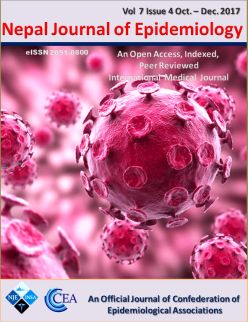Life expectancy and years of life lost in HIV patients under the care of BandarAbbas Behavioral Disorders Counseling Center
DOI:
https://doi.org/10.3126/nje.v7i4.20627Keywords:
Life Expectancy (LE), Average Years of Life Lost (AYLL), HIV/AIDS patients, CD4 countAbstract
Background: HIV epidemic is mostly targeted adults and has numerous negative health, social, economic, cultural and political consequences. In this study Life Expectancy (LE) and Average Years of Life Lost (AYLL) in HIV/AIDS patients are estimated.
Materials and Methods: In this descriptive study all the patients at the age of 18 and more under the care of BandarAbbas Behavioral Disorders Counseling Center (BBDCC) during 2005-2015 are included. The town of BandarAbbas is center of Hormozgan Province in southern Iran. LE and AYLL have been estimated based on Life Table.
Results: One hundred thirty four of the 426 eligible patients died during the study period. Compared to the general population LE for HIV/AIDS patients at age 20 is 46 years less in comparison with the general population of BandarAbbas. Moreover, a total of 8839 years of life lost during 2005-2015.
Conclusion: LE in HIV/AIDS patients is less than LE among BandarAbbas general population and AYLL among them is more than general population. Most of the years of life lost are preventable if the health care system seriously will implement programs to control HIV/AIDS.
Nepal J Epidemiol. 2017;7(4); 702-712.
Downloads
Downloads
Published
How to Cite
Issue
Section
License
- Upon acceptance Copyright on any research article is transferred in full to the Confederation of Epidemiological Associations (CEA) and International Nepal Epidemiological Association (INEA). The copyright transfer includes the right to reproduce and distribute the article in any form of reproduction (printing, electronic media or any other form).
- Articles in the Nepal Journal of Epidemiology are Open Access articles published under the Creative Commons CC BY License (https://creativecommons.org/licenses/by/4.0/)
- This license permits use, distribution and reproduction in any medium, provided the original work is properly cited.




